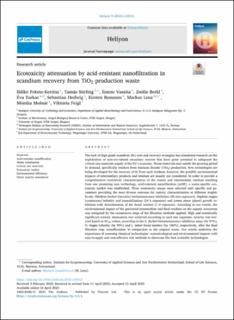| dc.description.abstract | The lack of high-grade scandium (Sc) ores and recovery strategies has stimulated research on the exploitation of non-ore-related secondary sources that have great potential to safeguard the critical raw materials supply of the EU’s economy. Waste materials may satisfy the growing global Sc demand, specifically residues from titanium dioxide (TiO2) production. New technologies are being developed for the recovery of Sc from such residues; however, the possible environmental impacts of intermediary products and residues are usually not considered. In order to provide a comprehensive ecotoxicity characterisation of the wastes and intermediate residues resulting from one promising new technology, acid-resistant nanofiltration (arNF), a waste-specific ecotoxicity toolkit was established. Three ecotoxicity assays were selected with specific test parameters providing the most diverse outcome for toxicity characterisation at different trophic levels: Aliivibrio fischeri (bacteria) bioluminescence inhibition (30 min exposure), Daphnia magna (crustacean) lethality and immobilisation (24 h exposure) and Lemna minor (plant) growth inhibition with determination of the frond number (7 d exposure). According to our results, the environmental impact of the generated intermediate and final residues on the aquatic ecosystem was mitigated by the consecutive steps of the filtration methods applied. High and statistically significant toxicity attenuation was achieved according to each test organism: toxicity was lowered based on EC20 values, according to the A. fischeri bioluminescence inhibition assay (by 97%), D. magna lethality (by 99%) and L. minor frond number (by 100%), respectively, after the final filtration step, nanofiltration, in comparison to the original waste. Our results underline the importance of assessing chemical technologies’ ecotoxicological and environmental impacts with easy-to-apply and cost-effective test methods to showcase the best available technologies. | en_US |
